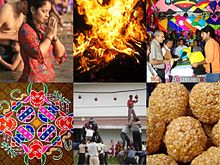Makar Sankranti
Makar Sankranti is a Hindu festival that is celebrated in very different ways and with different mythological references in different areas of the Indian subcontinent and Nepal.
According to the Hindu lunisolar calendar , in January the sun goes on its northern orbit in the sign of Makara (on January 14th or 15th). This Sankranti , the solstice , marks a period of time that brings blessings according to old Hindu tradition. As at the same time in the Tamil harvest festival Pongal , the harvest of sugar cane also plays an important role in Makar Sankranti state Maharashtra . In every house the women prepare til-gud , sweets from the sugar of the fresh sugar cane, mixed with sesame seeds, til , and give them away to neighbors and friends by saying a saying: " Til-gud ghya, god god bola " - " Take this sweet Til and say sweet words ". One should give it to everyone and end all hostilities with it. This aspect of reconciliation underlines the importance of celebrations not only for marking the cyclical change in nature, but also for the spiritual development of people and society.
In Gujarat , Makar Sankranti is the start of the hang-gliding season and enthusiastic competitions are held everywhere.
The Ganges estuary on the Indian Ocean in the state of West Bengal becomes Makar Sankranti and the center of one of the largest pilgrimage festivals of the Gangasagar Mela : without any collective organization, tens of thousands of believers arrive - to plunge into the holy water praying at an astrologically precise minute. The mythical background of this ocean festival is the story of Bhagirath, who is said to have brought Ganga , as Hindus call the river Ganges , from the Himalayas to the earth (see also Bhagirathi ). The companion animal ( Vahana ) of the personified goddess Ganga is Makar (or Makara ), a crocodile-like sea animal.
Around the same time that Makar Sankranti is celebrated in many areas of India, Lohri is celebrated in Punjab (January 13th): Here too, the end of the coldest time of the year is celebrated. Families and friends gather around a bonfire with happy singing, throwing rice and sweets into the flames as an offering to Agni , the divine in his fiery form.
literature
- Ajay Das: Faiths, Fairs & Festivals of India . Better Books, Panchkula 2007, ISBN 978-81-903177-7-1 .
- DG Gururani: Indian Fairs & Festivals . Akansha Publishing House, New Delhi 2007, ISBN 978-81-8370-077-1 .
- Stefano Piano: Religion and Culture of India . Böhlau, 2004, ISBN 9783825225070 .
Web links
Individual evidence
- ↑ GD Gururani: Indian Fairs & Festivals . Akansha Publishing House edition. New Delhi 2007, ISBN 978-81-8370-077-1 , pp. 146-148 .
- ↑ Gangasagar Mela (Festival) 2018 - India's 2nd Biggest Fair You Shouldn't Miss . November 15, 2017 ( theindia.co.in [accessed May 21, 2018]).
- ↑ LOHRI: THE BONFIRE FESTIVAL | The Indian Panorama. Retrieved May 21, 2018 (American English).
